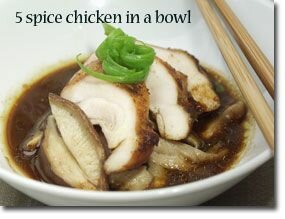If you don't know what to serve for dinner tonight ...
The unique use of spices in the broth combined with the chicken gives you a great combination of flavors in this easy-to-prepare addition to your Healthiest Way of Eating. Enjoy!

Ingredients:
- 2 boneless, skinless chicken breasts (6 oz each), cut in 2-inch pieces
- 4 cups chicken broth
- 1/2 inch sliced fresh ginger, sliced (or 1/2 tsp dried ginger)
- 6 whole cloves
- 2 cinnamon sticks
- 5 star anise
- 1/2 tsp dried fennel seeds
- 1 medium-sized onion, chopped in big pieces
- 3 cloves garlic, chopped in big pieces
- 6 whole medium dried shiitake mushrooms
- 1 lb green beans, ends cut off
- 1/2 cup minced scallions
- Chop onion and garlic and let sit for 5 minutes to bring out their hidden health-promoting benefits.
- Healthy Sauté onion in a medium saucepan over medium-low heat for about 5 minutes, stirring frequently. Add garlic and continue to sauté for another minute. Add chicken broth, ginger, cloves, cinnamon stick, star anise, fennel seeds, and shiitake mushrooms. Turn heat to medium and simmer for 15 minutes.
- While broth is simmering, cut ends off beans and cut into 1-inch pieces.
- Strain broth mixture (saving shiitake mushrooms) and put liquid back into pan. Bring to a boil, add chicken pieces and green beans, and cook on medium heat for 7-10 minutes. You may need to skim the surface a little while chicken pieces are cooking. Slice shiitake mushrooms and add to chicken and broth. Add scallion as well as salt and pepper to taste.
- Napa Cabbage Salad
In-Depth Nutritional Profile for 5-Spice Chicken in a Bowl
Healthy Food Tip
What are saturated fats and are they considered bad?
The "saturated" in "saturated fats" refers to the fact that these fats are saturated with hydrogen and carbon atoms. They contain these atoms in as many places as possible; hence they are "saturated."
Saturated fats tend to be solid at room temperature. The higher saturated fat content of foods like butter and beef fat is one of the key reasons that these fats tend to stay solid at room temperature. Unsaturated fats tend to be liquid at room temperature. Most plant oils tend to be liquid at room temperature precisely because they contain such a high percentage of unsaturated fats.
Saturated fats are not automatically bad for us, and they are contained in many of the World's Healthiest Foods. "Saturated fat" is a chemical term that many people have mistakenly come to equate with meats and animal products. However, the relationship between saturated fat and food is not nearly this simple, nor is the relationship between saturated fat and health.
Virtually all fat-containing foods contain some saturated fat. There's about 1.25 grams of saturated fat in every tablespoon of flaxseed oil (about 9% of it's total fat), and in every tablespoon of olive oil, you'll find about 2 grams of saturated fat (or about 14% of its total fat). While the relatively small amount of saturated fat content of these foods is seldom placed in the spotlight, it is a natural part of their composition and their health-supportive properties. Very lean meats, like trimmed eye of round steak, will also contain about 2 grams of saturated fat per 4-ounce serving, and skinned baked chicken breast will contain just over 1 gram in this same amount. These very small amounts of saturated fat are amounts that most of us could easily include in our Healthiest Way of Eating and are amounts I consider to be both healthy and necessary.
The health risks associated with saturated fat all involve excessive consumption. Saturated fats are considered "bad" for us because in the U.S. we tend to consume them to excess, and this excess intake is associated with health problems. Excessive intake of saturated fat is the main dietary cause of high blood cholesterol in both men and women, and it may also increase the risk of both prostate cancer and Parkinson's disease in men. The National Academy of Sciences has not set a daily limit for saturated fat intake and simply recommends eating as little saturated fat as possible while still consuming an adequate amount of other nutrients.
Organizations like the American Heart Association recommend that you keep your saturated fat intake under 7% of total calories. If you eat 2,000 calories per day, that recommendation means 140 or fewer calories from saturated fat, or about 15.5 grams.
To reach an excessive level of saturated fat, what kinds of food would you need to consume? An egg, cheese and bacon croissant would typically provide you with more than 15 grams of saturated fat and put you at or above the recommended limit. So would a 6-ounce serving of broiled filet mignon steak. You would also be over the limit with four 8-ounce glasses of whole milk, and you would be pretty close with two tablespoons of butter.

No comments:
Post a Comment